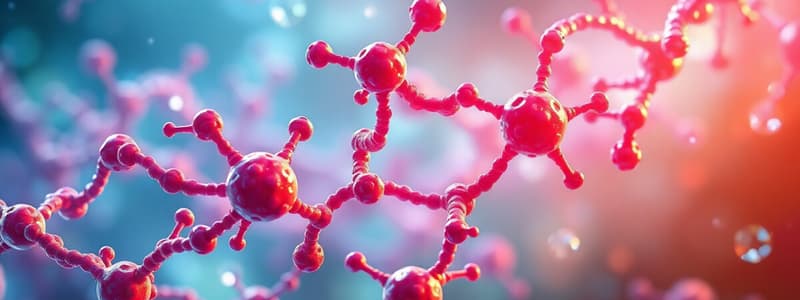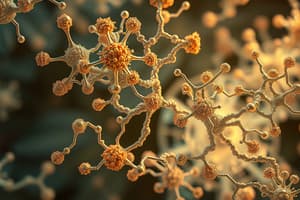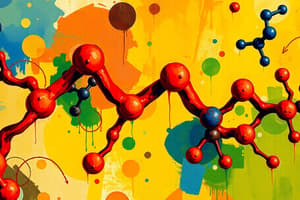Podcast
Questions and Answers
What are carbohydrates formed from in green plants?
What are carbohydrates formed from in green plants?
- Sunlight and nitrogen
- Minerals and water
- Oxygen and nutrients
- Water and carbon dioxide (correct)
Which process do plants use to convert sunlight into chemical bonds in carbohydrates?
Which process do plants use to convert sunlight into chemical bonds in carbohydrates?
- Photosynthesis (correct)
- Aerobic respiration
- Anaerobic respiration
- Transpiration
What is the minimum number of carbon atoms required for a molecule to be classified as a carbohydrate?
What is the minimum number of carbon atoms required for a molecule to be classified as a carbohydrate?
- 3 carbon atoms (correct)
- 4 carbon atoms
- 2 carbon atoms
- 1 carbon atom
What role does sunlight play in the formation of carbohydrates in plants?
What role does sunlight play in the formation of carbohydrates in plants?
Which of the following is true regarding the process of photosynthesis?
Which of the following is true regarding the process of photosynthesis?
What substance in plants cannot be digested by humans due to a lack of necessary enzymes?
What substance in plants cannot be digested by humans due to a lack of necessary enzymes?
What role does chitin play in insects?
What role does chitin play in insects?
What type of biological macromolecule are proteins classified as?
What type of biological macromolecule are proteins classified as?
Which of the following statements is true regarding cellulose and human digestion?
Which of the following statements is true regarding cellulose and human digestion?
The bonds that link amino acids to form proteins are called what?
The bonds that link amino acids to form proteins are called what?
What distinguishes β-glucopyranose from other forms of glucose?
What distinguishes β-glucopyranose from other forms of glucose?
Which configuration represents the cyclic form of glucose as an aldose hexose?
Which configuration represents the cyclic form of glucose as an aldose hexose?
What type of sugar is glucose classified as?
What type of sugar is glucose classified as?
In the Haworth configuration of glucose, what is significant about the anomers?
In the Haworth configuration of glucose, what is significant about the anomers?
Which carbon number in glucose determines whether it is β-glucopyranose?
Which carbon number in glucose determines whether it is β-glucopyranose?
Which type of interaction is NOT involved in the tertiary structure of proteins?
Which type of interaction is NOT involved in the tertiary structure of proteins?
Which of the following interactions contributes to the tertiary structure of proteins through non-covalent means?
Which of the following interactions contributes to the tertiary structure of proteins through non-covalent means?
What type of interaction is characterized by induced dipoles in protein structures?
What type of interaction is characterized by induced dipoles in protein structures?
In the context of protein tertiary structure, which interactions can influence the folding of the protein?
In the context of protein tertiary structure, which interactions can influence the folding of the protein?
Which of these interactions primarily involves the attraction between charged groups?
Which of these interactions primarily involves the attraction between charged groups?
What does ΔG represent in a biological process?
What does ΔG represent in a biological process?
How does a living cell primarily function in terms of energy?
How does a living cell primarily function in terms of energy?
Which of the following best describes the role of a living cell related to energy?
Which of the following best describes the role of a living cell related to energy?
Which statement accurately reflects the metabolic activity of a living cell?
Which statement accurately reflects the metabolic activity of a living cell?
What is the significance of ΔG in the context of metabolic pathways?
What is the significance of ΔG in the context of metabolic pathways?
What does metabolism refer to in a biological context?
What does metabolism refer to in a biological context?
Which of the following statements is true regarding free energy and reactions?
Which of the following statements is true regarding free energy and reactions?
How does changing the concentration of reactants affect ΔG?
How does changing the concentration of reactants affect ΔG?
What is the primary role of free energy in chemical reactions?
What is the primary role of free energy in chemical reactions?
Which of the following best defines a spontaneous reaction?
Which of the following best defines a spontaneous reaction?
Flashcards
Plant Carbohydrate Source
Plant Carbohydrate Source
Plants produce carbohydrates from carbon dioxide and water during photosynthesis, using sunlight's energy.
Photosynthesis
Photosynthesis
The process where plants convert sunlight into chemical energy to make carbohydrates.
Carbohydrate Structure
Carbohydrate Structure
The simplest carbohydrate molecule contains three carbon atoms.
Carbon Dioxide & Water
Carbon Dioxide & Water
Signup and view all the flashcards
Energy Source in Carbohydrates
Energy Source in Carbohydrates
Signup and view all the flashcards
Haworth configuration
Haworth configuration
Signup and view all the flashcards
Aldose hexose
Aldose hexose
Signup and view all the flashcards
Anomers
Anomers
Signup and view all the flashcards
β-Glucopyranose
β-Glucopyranose
Signup and view all the flashcards
Hydroxyl group (C#1)
Hydroxyl group (C#1)
Signup and view all the flashcards
Metabolism
Metabolism
Signup and view all the flashcards
What does metabolism not affect?
What does metabolism not affect?
Signup and view all the flashcards
Cellulose in plants
Cellulose in plants
Signup and view all the flashcards
Chitin in insects
Chitin in insects
Signup and view all the flashcards
Protein monomers
Protein monomers
Signup and view all the flashcards
Peptide bonds
Peptide bonds
Signup and view all the flashcards
Protein polymers
Protein polymers
Signup and view all the flashcards
Energy Factory
Energy Factory
Signup and view all the flashcards
Free Energy Change
Free Energy Change
Signup and view all the flashcards
Metabolic Pathways
Metabolic Pathways
Signup and view all the flashcards
What is ΔG?
What is ΔG?
Signup and view all the flashcards
Why is ΔG important?
Why is ΔG important?
Signup and view all the flashcards
R group interactions
R group interactions
Signup and view all the flashcards
Hydrogen bond
Hydrogen bond
Signup and view all the flashcards
Ionic bonding
Ionic bonding
Signup and view all the flashcards
Dipole-dipole interactions
Dipole-dipole interactions
Signup and view all the flashcards
London dispersion forces
London dispersion forces
Signup and view all the flashcards
Study Notes
Biochemistry Introduction
- Biochemistry studies chemical processes in living organisms.
- It examines the structure, functions, and properties of biomolecules.
- Knowledge of biochemistry is essential for all life sciences.
Biomolecules
- Biomolecules are compounds produced by living organisms.
- Macromolecules include proteins, lipids, carbohydrates, and nucleic acids.
- Micro-molecules are smaller molecules like amino acids and monosaccharides.
- Organic molecules are carbon-based, more complex than non-organic.
- Non-organic molecules include metals and water.
Macromolecules
- Carbohydrates: Main function is energy source (short-term).
- Most abundant organic molecules in nature, literally "hydrate of carbon."
- Chemical formula (CH₂O)n (n=3 or more).
- Formed in plants by photosynthesis from CO2 and water.
- Simple sugars (monosaccharides), linked by glycosidic bonds to form disaccharides, oligosaccharides,and polysaccharides.
- Proteins: Structure and function of cells and the body.
- Polymers of amino acids linked by peptide bonds.
- 20 standard amino acids in mammals.
- Diverse functions including structural, enzymatic, hormonal, transport, and defense.
- Lipids: Energy storage and cell membranes.
- Heterogenous group of hydrophobic molecules.
- Long-term energy storage.
- Components of cell membranes (phospholipids).
- Function in protection and insulation.
- Fatty acids (alkyl chain with a terminal carboxyl group).
- Nucleic Acids: Genetic information.
- DNA and RNA.
- Polymers of nucleotides (containing a nitrogenous base, pentose sugar, and phosphate group).
- Store and express genetic information.
Carbohydrates Detailed
- Monosaccharides (simple sugars): basic units of carbohydrates.
- Names reflect the number of carbons (e.g., triose, pentose, hexose).
- Classified as aldoses (aldehyde group) or ketoses (ketone group).
- Glucose, galactose, fructose are important monosaccharides.
- Disaccharides: Two monosaccharides linked by a glycosidic bond, (e.g., lactose, sucrose, maltose).
- Polysaccharides: Chains of monosaccharides, (e.g., glycogen, starch, cellulose, chitin).
Key Terms and Concepts
- Endergonic reactions: Need energy input (positive ∆G)
- Exergonic reactions: Release energy (negative ∆G)
- Enzymes: Speed up reactions by lowering the activation energy.
- Metabolism: The totality of all chemical reactions in a cell.
- Anabolic pathways: Build molecules.
- Catabolic pathways: Break down molecules.
- ATP: Energy currency of the cell.
Other Important Topics
- Structure of proteins (primary, secondary, tertiary, and quaternary).
- Functions of proteins: Structural, enzymatic, hormonal, transport, defense.
- Lipids.
- Nucleic acids: DNA, RNA.
- Metabolic diseases: Examples like diabetes and phenylketonuria (PKU).
Studying That Suits You
Use AI to generate personalized quizzes and flashcards to suit your learning preferences.



